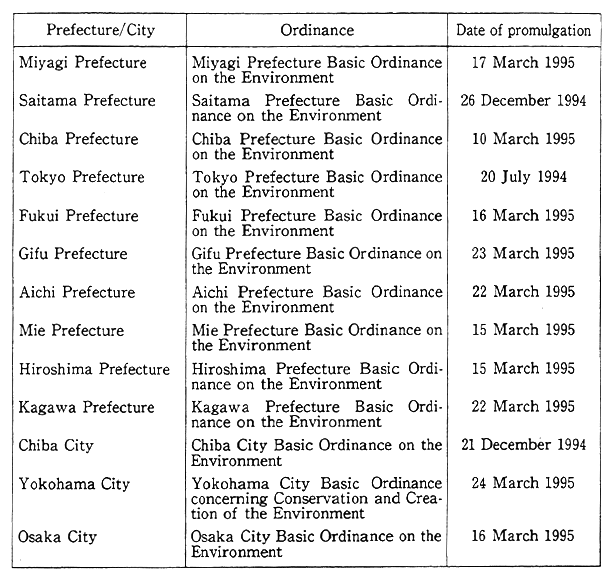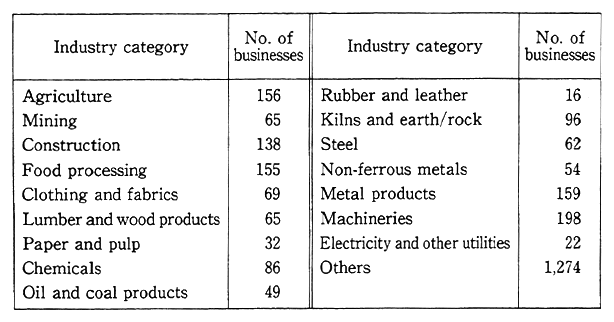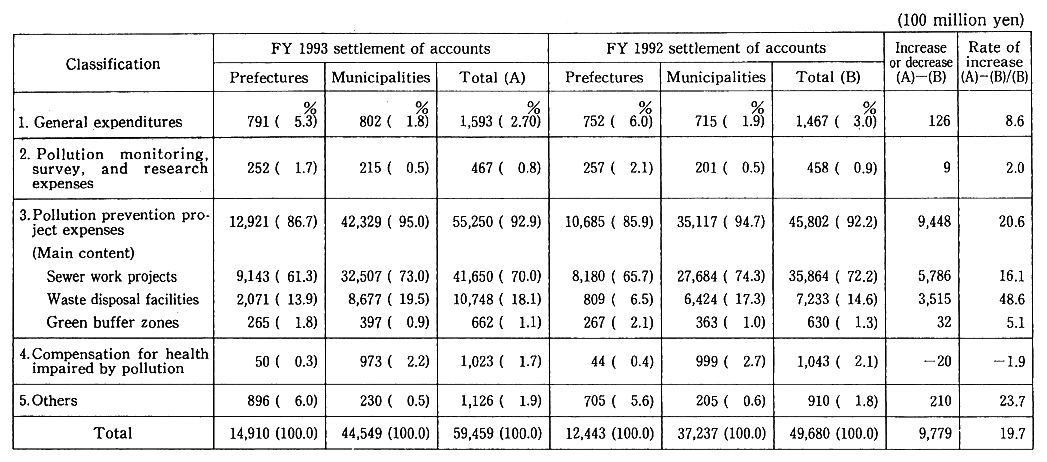Quality of the Environment in Japan 1995
Section3. Health Measures at Schools
The Ministry of Education carried out the following measures to promote public health:
1) Projects to promote the planting at schools
The ministry provides a portion of the necessary costs to local governments for improvement of learning abilities and promotion of the active physical and mental health of children who are students at public schools in areas suffuring from air pollution and other places. The total budget allotted in fiscal 1994 was 168.84 million yen.
2) Projects for the promotion of nature classes
The ministry provides a portion of the necessary costs to local governments and to schools for nature class projects to nurture the physical and mental health of children in elementary and junior high schools, in which school education activities are conducted through group outdoor stays in the natural environment. The total allotted in fiscal 1994 was 693.9 million yen.
3) Construction work to prevent pollution in public schools
The ministry provides subsidies for costs required in reconstruc-tion of buildings deemed extremely inappropriate for the educational environment because of pollution, and in construction work to prevent pollution. Total costs allotted in fiscal 1994 was 1,093 million yen.
4) Loans for pollution
The Japan Private School Promotion Foundation offers funding loans for pollution prevention work, such as noise-insulating work, in private schools, and the total amount loaned in fiscal 1994 was 500 million yen.
5) Project for promotion of young people's experience in nature
To promote projects that comprehensively promote young peo-ple's natural experience activities through long-term camps, for the purpose of developing environmental education, the ministry subsidizes the necessary costs to prefectures and municipalities so that they can establish promotion councils, implement nature experience activities, and organize meetings to present the experiences. The total allotted in fiscal 1994 was 105 million yen.
Section4. Environmental Conservation Policies by Local Governments
Local governments act based on ordinances to issue regulations and guidance to businesses for conservation of the environment, to monitor, measure, and control pollution, and are the main authorities for conducting various kinds of pollution countermeasure projects and nature conservation projects. The importance of the role of local governments is stated clearly in Chapter 3, Section 3 of the Basic Environment Plan.
It is important that the environmental conservation policies taken by local governments be comprehensively adopted out of consid-eration for the characteristics of local nature, the state of the environ-ment, and trends in the socioeconomy, and also be adopted in response to the needs of local residents. Many local governments are adopting ordinances in regard to environmental conservation and to regional environmental plans, in order to systematically promote regional envi-ronmental conservation policies.
Under these kinds of ordinances, local public authorities are conducting such policies as waste recycling measures, studies into, promotion and systematization of environmental assessments, introduc-tion and promotion of energy that places less burdens on the environ-ment, guidance on rationalized-use of antomobile, utilization of low-pollution vehicles, improvement of transport infrastructure, promotion of domestic effluent countermeasures, promotion of neighborhood noise reduction and tree-planting, and use of trusts to conserve greenery.
Funding for these policies comes either from independent local resources or from subsidies provided by the national government for each project. Funding for environmental conservation policies in local financing plans amounted to 220 billion yen in fiscal 1994, as an effort to improve local grant tax measures.
1. Current State of Organization and Personnel for Environmental Administration
The number of personnel in charge of pollution (excluding wastes and sewer-related affairs, which also goes for municipalities) in prefec-tures and designated metropolitan cities was 7,448 as of 1 October 1993, with 1,842 personnel in charge of nature conservation.
And the number of municipalities with bureaus or sections (offices) dedicated to pollution came to 233 communities as of 1 October 1993, with 733 more communities having posts for officials in charge of pollution or otherwise assigning someone to that task. These commu-nities accounted for 298% of all municipalities.
2. State of Ordinance Enforced
Environmental conservation-related ordinances by local govern-ments are very important in the promotion of environmental conserva-tion policies at local level. In particular, since the Basic Environment Law was enacted in November 1993, local governments have begun to show movement in enacting basic environmental decrees. Environmen-tal conservation-related ordinances divide broadly into four types, in-cluding 1) basic environmental ordinances, 2) pollution prevention ordi-nances, 3) ordinances for conservation of the natural environment, and 4) other environmental conservation-related ordinances (including ordi-nances on environmental impact assessment).
Basic environmental ordinances, in line with the concepts of the Basic Environment Law, can be said to be the decrees that stipulate the most basic items concerning the environmental conservation policy of local public authorities, and they were enacted during fiscal 1994 by 13 prefectures and designated metropolitan cities (Table 15-4-1).
Pollution prevention ordinance and the nature conservation ordi-nance express the basic stances of local governments in the respective fields of pollution prevention and nature conservation. As of 1 October 1993, there were 54 prefectures and designated metropolitan cities that had enacted the pollution prevention ordinances and 48 that had enacted the nature conservation ordinances.
Other kinds of environmental conservation ordinances include ordinances on environmental impact assessment and ordinances banning littering empty cans.
Enactments of environmental conservation-related ordinances by municipalities are as shown in Table 15-4-2.
3. Conclusion of Pollution Control Agreement
The number of pollution control agreements signed amounted to about 2,200 between October 1992 and September 1993. The type of partner, by industry, signing the agreements are as shown in Table 15-4-3. As can be seen, the secondary industries are not the only ones involved, with the "others" classification that centers mainly on tertiary industry establishments such as those found in the services industry accounting for about half of the total.
Of these agreements, 127 involved residents participating as interested parties, and 85 involved residents participating as witnesses.
The reasons given for the signing of so many pollution control agreements included the following:
1) In addition to policies based on ordinances, detailed pollution prevention policies could be appropriately implemented in response to the geographical and social conditions in the affected local area.
2) Corporations recognized that obtaining the agreement of local residents on their location was essential in achieving the smooth opera-tion of corporate activities.
Table 15-4-1 Basic Environmental Ordinances Adopted by Prefectures and Designated Metropolitan Cities in FY 1994

Note These include pre-existing ordinance amended which subsequently became the basic ordinance on the environment
Table 15-4-2 Adoption of Environmental Conservation Ordinances by Municipalities

Table 15-4-3 Number of Businesses Signing Pollution Control Agreements by Industry Category

Notes: 1. Data by Environment Agency
2. List covers agreements made between 1 October 1992 and 30 September 1993.
4. Assistance for Installation of Pollution Control Facilities
There were about 1,300 cases of loan financing for local govern-ments' own pollution control facilities in fiscal 1992, for total financing of about 17.8 billion yen.
The main targets for financing was facilities for prevention of water or air pollution, and facilities for noise countermeasures.
In addition, there were about 16,000 cases of subsidies for pollu-tion prevention facilities owned by local governments in fiscal 1992, for a subsidy total of about 6.6 billion yen.
5. Pollution Countermeasure Expenses
Pollution countermeasure expenses by local governments (includ-ing those incurred by local public corporations) amounted to 5.9459 trillion yen (prefectures, 1.491 trillion yen, and municipalities, 4.4549 trillion yen) in fiscal 1993. Compared with the previous, this represented a rise of 977.9 billion yen (prefectures, 246.7 billion yen, and municipal-ities, 731.2 billion yen), or a 19.7% increase (Table 15-4-4).
By type of pollution countermeasure expense, pollution preven-tion projects accounted for 5.525 trillion yen (92.9% of the total), foll-owed by general expenses, at 159.3 billion yen (2.7% of the total).
And by type of pollution prevention project, sewer system devel-opment projects accounted for 4.165 trillion yen, holding a high 70.0% of all pollution countermeasure expenses, followed by waste disposal facility development projects, at 1.0748 trillion yen (181% of the total).
Section5. Development of Environmental Pollution Control Systems in the Private Sector
1. Implementing Pollution Prevention Control Systems by Businesses
The Law concerning Pollution Prevention Organizations in Speci-fied Factories came into effect in June 1971 for the purpose of develop-ing environmental pollution prevention systems at factories. And in September 1972, specified factories have been required to assign envi-ronmental pollution control managers for control pollution prevention operations as well as to assign environmental pollution control opera-tors and other staff with special knowledge and skills, resulting in the development of environmental pollution prevention organizations being developed at about 20,000 specified factories.
According to a survey of the prefectures on the state of assign-ment for environmental pollution control manager, etc., there were as of the end of March 1993 about 24,000 environmental pollution control managers (including their deputies) and about 40,000 environmental pollution control operators (including their deputies).
In addition, national examinations and lecture courses are con-ducted under the law to help environmental pollution control managers and operators obtain qualifications, and the number who have obtained qualifications to date totals 439,393 people.
Table 15-4-4 Settlement of Pollution Measure Accounts at Local Governments (FY 1993)

Note: Doubling up of subsidies, liabilities and expenses incurred in prefectures and in municipalities, has been omitted.
(1) National examination for environmental pollution control managers and operators
The Ministry of International Trade and Industry has administer-ed the national examination for environmental pollution control man-agers and operators every year since fiscal 1971. The national examina-tion for fiscal 1994 was conducted on 25 September and 2 October 1994, with the number of exam applicants reaching 25,681 people, the number actually taking the examination being 21,161 people, and the number of people passing the examination reaching 5,250 people. The total number who had passed the national examination as of fiscal 1994 is 239,059 people.
(2) Lecture courses
In addition to the above, another way to obtain the qualifications for an environmental pollution control manager or operator is to com-plete the lecture courses for certification. This system is for those who possess certain technical qualifications or those who have certain academic qualifications and practical experience relating to pollution prevention. Those who complete the course acquire the same qualifica-tions as those who pass the national examination. The number who had completed the qualifying course as of fiscal 1994 was 200,336 people.
2. Rationalization of Environmental Monitoring in the Private Sector
The Ministry of International Trade and Industry completely amended the Measurement Law, with enactment and promulgation of the new Measurements Law on 20 May 1992, and coming into force on 1 November 1993. The law targets such pollution measurement instru-ments as flow meters, noise meters, vibration level meters, and density meters, requiring that manufacturers of these instruments file business applications, and requiring inspections of a certain number of pollution measurement instruments.
In addition, the business engaged in environmental measurement verification are required to register with the prefectural governor and to accept inspections of the instruments used for measurement verifica-tion.
Those engaged in measurement and verification of density and noise levels are required to register as environmental measurement verification operators. Moreover, a system of environmental measure-ment operator was established in 1974, and those people who pass the national examination or complete the requisite courses are registered with the Minister of International Trade and Industry. The number registered had reached 6,679 people as of the end of November 1993.